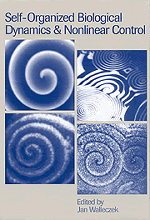 Self-Organized Biological Dynamics and Nonlinear Control
Self-Organized Biological Dynamics and Nonlinear Control Book contents
- Frontmatter
- Contents
- List of contributors
- Preface
- The frontiers and challenges of biodynamics research
- Part I Nonlinear dynamics in biology and response to stimuli
- Part II Nonlinear sensitivity of biological systems to electromagnetic stimuli
- Part III Stochastic noise-induced dynamics and transport in biological systems
- 10 Stochastic resonance: looking forward
- 11 Stochastic resonance and small-amplitude signal transduction in voltage-gated ion channels
- 12 Ratchets, rectifiers, and demons: the constructive role of noise in free energy and signal transduction
- 13 Cellular transduction of periodic and stochastic energy signals by electroconformational coupling
- Part IV Nonlinear control of biological and other excitable systems
- Index
10 - Stochastic resonance: looking forward
Published online by Cambridge University Press: 14 August 2009
- Frontmatter
- Contents
- List of contributors
- Preface
- The frontiers and challenges of biodynamics research
- Part I Nonlinear dynamics in biology and response to stimuli
- Part II Nonlinear sensitivity of biological systems to electromagnetic stimuli
- Part III Stochastic noise-induced dynamics and transport in biological systems
- 10 Stochastic resonance: looking forward
- 11 Stochastic resonance and small-amplitude signal transduction in voltage-gated ion channels
- 12 Ratchets, rectifiers, and demons: the constructive role of noise in free energy and signal transduction
- 13 Cellular transduction of periodic and stochastic energy signals by electroconformational coupling
- Part IV Nonlinear control of biological and other excitable systems
- Index
Summary
Introduction
Stochastic resonance (SR) has been a familiar topic to physicists since the early 1980s, to sensory neurobiologists since the early 1990s and is now becoming familiar to medical researchers interested in the possibilities it offers for new diagnostic and therapeutic techniques. It has been the subject of numerous editorial commentaries and three major reviews. In this chapter, I review very briefly the fundamental classical physical process and its realization or study in various substrates ranging from single elements to arrays of elements over a range of size scales. The emphasis is on the classical phenomenology and its applications in the biological or medical sciences. I then attempt to have a look into the future.
SR was first proposed as a theoretical explanation for the observed recurrences of the Earth's ice ages. In this view, dynamical orbital processes, which moved the Earth's orbit slightly closer to the sun periodically on an approximately 100 000-year period, were known to be too small to account for the reduced insolation necessary to trigger the onset of a glacial period in the Earth's climate. But if a temporal randomness in the insolation, or noise, was introduced into the dynamical motion of the climate state point, such quantities as the frequency spectrum of the ice age recurrences could be reproduced with some accuracy.
- Type
- Chapter
- Information
- Self-Organized Biological Dynamics and Nonlinear ControlToward Understanding Complexity, Chaos and Emergent Function in Living Systems, pp. 236 - 256Publisher: Cambridge University PressPrint publication year: 2000
- 10
- Cited by


